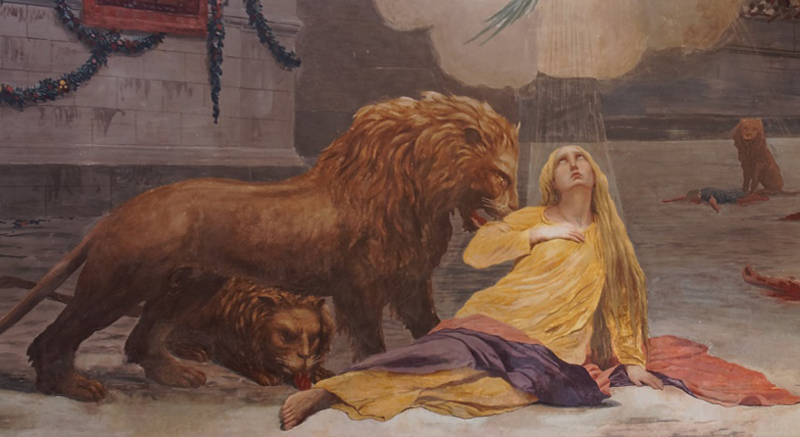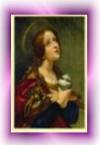St. Euphemia lived in the third century AD, born about the year 289 of pious Christian parents. Her father was a senator named Philophronos and her mother was Theodosia. She was born in Chalcedon which is a town located across the Bosporus from the city of Byzantium, later known as Constantinople. Like her pious parents, Euphemia grew to love Christ devoting herself to prayer, fasting and works of charity.
About the year 303 AD the Roman governor of Chalcedon, Priscus, issued an order that all citizens take part in sacrifices to the pagan god Ares. Euphemia went into hiding with a group of other Christians but were discovered and arrested. Because of their refusal to participate in the pagan rites, Euphemia and her fellow Christian underwent abuse and tortures from their guards. Euphemia, since she was the youngest of the group, was separated from the rest with the hope that in isolation from her friends she would be more easily persuaded to abandon her Christian Faith. Euphemia was promised freedom and riches if she would deny Christ yet she remained steadfast as she faced more threats of torture. She trusted in the words of her Lord: “Do not fear those who kill the body but cannot kill the soul. But rather fear Him who is able to destroy both soul and body in hell.” (Matthew 10:28) She was tied to a spiked wheel which slowly tore her flesh and then two soldiers threw her into a fiery furnace. When these soldiers, Victor and Sosthenes, saw brilliant angels in the flames, they were terrified and refused to carry out their orders. Both these men declared their faith in the God of Euphemia and were to condemned to death: thrown into the arena to be eaten by wild animals. As they died they were heard to cry out to God to receive them into His Kingdom. Other soldiers filled the order which Victor and Sosthenes refused, and cast Euphemia into the furnace. Miraculously, like the Three Youths in the Fiery Furnace from the Book of Daniel, Euphemia remained unharmed.
Finally, like Victor and Sosthenes, Euphemia was brought to the arena and thrown to the wild animals. There she gave up her soul to the arms of the Lord Jesus to whom she was always faithful, knowing the promise of the Scriptures: “For if we died with Him, we shall also live with Him”. (2 Timothy 2:11) At the moment of her death there as a great earthquake causing the guards and all the spectators in the arena to rush or the exits. In the ensuing confusion the parents of the saint were able to retrieve the body of their daughter and reverently bury her. Eventually, with the legalization of Christianity by the Emperor St. Constantine in 313 AD, a great church was built over the grave of the martyr.
Miracle At The Council
The fame of St. Euphemia became even greater more than 100 years after her martyrdom because of a miracle she performed at the Fourth Ecumenical Council in 451 AD. Following the legalization of Christianity and the end of the persecutions, questions and differences of opinion arose among Christians. The questions centered on the person of Christ: was He truly a human person or just appeared to be? Was He truly God in the flesh or a mere creation of God? The Church assembled a series of worldwide councils, known as Ecumenical Councils to address these and other questions. The Fourth Council met in Chalcedon in the Church of St. Euphemia which contained the shrine of her holy relics. The 630 bishop/delegates met to consider the question: was Jesus truly human and truly divine? Some Christians were teaching that Jesus had one nature: divine and that his human nature was dissolved into His divine nature, much like a cube of sugar is dissolved in water. This teaching was known as monophysitism (mono – one ; physis – nature). The arguments raged back and forth with each side quoting Scripture and the ancient tradition of the Church to bolster their views. Finally, the holy Patriarch Anatolius of Constantinople proposed that the question be submitted to the guidance of the Holy Spirit through the prayers of the Holy Martyr Euphemia. The Orthodox side and the Monophysite side each wrote down their views on separate scrolls. In the presence of the Emperor Marcian, the two scrolls were placed in the casket of St. Euphemia, resting on her chest. Her casket was sealed with the imperial seal and placed under guard as each side devoted themselves to three days of prayer and fasting seeking the guidance of the Holy Spirit. On the third day the casket of the Martyr was opened, the Orthodox scroll was in the hand of St. Euphemia and the Monophysite scroll at her feet. The Council the issued the following decree:
“We, then, following the holy Fathers, all with one consent, teach people to confess one
and the same Son, our Lord Jesus Christ, the same perfect in Godhead
and also perfect in manhood ; truly God and truly man…”

